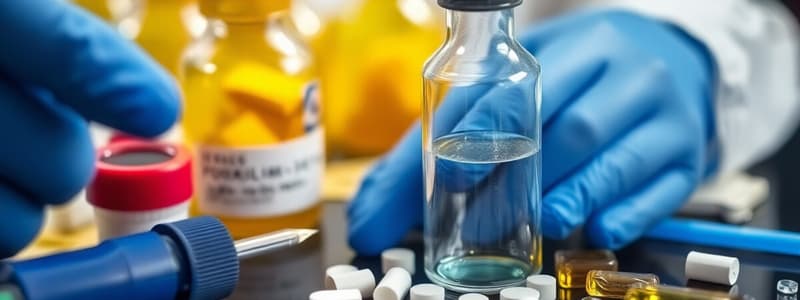Podcast
Questions and Answers
Which of the following best describes the primary mechanism by which fentanyl poses a high risk of overdose?
Which of the following best describes the primary mechanism by which fentanyl poses a high risk of overdose?
- It directly damages the heart muscle, leading to cardiac arrest.
- It disrupts normal respiratory control, causing breathing to stop. (correct)
- It induces a rapid increase in blood pressure, leading to stroke.
- It causes severe gastrointestinal distress, leading to dehydration and shock.
A patient presents with symptoms including muscle aches, stomach upset, and noticeable irritability. Which of the following toxins would most likely be responsible, based on the symptoms listed?
A patient presents with symptoms including muscle aches, stomach upset, and noticeable irritability. Which of the following toxins would most likely be responsible, based on the symptoms listed?
- Potassium chloride poisoning.
- Acute exposure to mercury. (correct)
- Lead poisoning from old paint.
- Arsenic poisoning from contaminated water.
What is the primary difference between a 'poison' and a 'toxin' according to the discussion?
What is the primary difference between a 'poison' and a 'toxin' according to the discussion?
- Poisons are only harmful in large doses, while toxins are harmful in any dose.
- Toxins are always more harmful than poisons.
- Toxins are produced by living organisms, while poisons are not. (correct)
- Poisons are always synthetic, while toxins are naturally occurring.
Which characteristic of a toxic substance is most directly related to the quantity required to produce a harmful effect?
Which characteristic of a toxic substance is most directly related to the quantity required to produce a harmful effect?
An individual develops a physiological dependence on a drug, experiencing intense cravings. However, they do not show the typical symptoms of withdrawal when attempting to stop. Based on this information, what term BEST describes their condition?
An individual develops a physiological dependence on a drug, experiencing intense cravings. However, they do not show the typical symptoms of withdrawal when attempting to stop. Based on this information, what term BEST describes their condition?
Which of the following most accurately describes the process of 'metabolism' in the context of toxicology?
Which of the following most accurately describes the process of 'metabolism' in the context of toxicology?
A patient presents with blue discoloration on their gum line, along with nausea, abdominal pain, and reports of insomnia. Based on the symptoms listed, which of the following toxins would be most suspected?
A patient presents with blue discoloration on their gum line, along with nausea, abdominal pain, and reports of insomnia. Based on the symptoms listed, which of the following toxins would be most suspected?
If a large quantity of a toxin is absorbed by the body, what is the most likely immediate consequence related to the liver's function?
If a large quantity of a toxin is absorbed by the body, what is the most likely immediate consequence related to the liver's function?
In cases where a person has died, which samples would a forensic toxicologist most likely examine to determine the presence of harmful substances?
In cases where a person has died, which samples would a forensic toxicologist most likely examine to determine the presence of harmful substances?
How does cyanide exert its toxic effect on the body?
How does cyanide exert its toxic effect on the body?
Which of the following best describes the primary distinction between a Schedule III and a Schedule IV controlled substance?
Which of the following best describes the primary distinction between a Schedule III and a Schedule IV controlled substance?
A patient is exhibiting symptoms of rapid heartbeat, muscle weakness, and anxiety. Which of the following substances is the most likely cause, according to the text?
A patient is exhibiting symptoms of rapid heartbeat, muscle weakness, and anxiety. Which of the following substances is the most likely cause, according to the text?
Which of the following statements accurately describes the classification of narcotics according to the provided text?
Which of the following statements accurately describes the classification of narcotics according to the provided text?
Which of the following best describes the physiological effects directly associated with hallucinogens as per the provided text?
Which of the following best describes the physiological effects directly associated with hallucinogens as per the provided text?
A substance is determined to be a CNS depressant, sleep-inducing, and highly addictive with multiple derivatives. Based on this description and the provided text, which class of drug is it most likely to be?
A substance is determined to be a CNS depressant, sleep-inducing, and highly addictive with multiple derivatives. Based on this description and the provided text, which class of drug is it most likely to be?
Flashcards
Toxicology
Toxicology
The study of the effects of drugs, poisons, and toxins on living organisms, including their absorption, distribution, metabolism, and excretion.
Poisons
Poisons
Chemicals that can cause serious harm to living organisms, either naturally occurring or manufactured.
Toxins
Toxins
Naturally occurring poisonous substances produced by living organisms.
ADME
ADME
Signup and view all the flashcards
Metabolism
Metabolism
Signup and view all the flashcards
Fentanyl
Fentanyl
Signup and view all the flashcards
Botulinum Toxin (Botox)
Botulinum Toxin (Botox)
Signup and view all the flashcards
Cocaine
Cocaine
Signup and view all the flashcards
Arsenic Poisoning
Arsenic Poisoning
Signup and view all the flashcards
Ricin
Ricin
Signup and view all the flashcards
Schedule I Drugs
Schedule I Drugs
Signup and view all the flashcards
Hallucinogens
Hallucinogens
Signup and view all the flashcards
Narcotics
Narcotics
Signup and view all the flashcards
Study Notes
Forensic Toxicology and Pharmacology
- Forensic Toxicologists analyze evidence to determine if toxins/drugs are present.
- Toxicology is the study of drugs, poisons, toxins, and metabolites (byproducts of the body breaking down drugs/poisons).
- Poisons are natural or manufactured chemicals that can cause serious harm (e.g., arsenic, rat poison).
- Toxins are naturally occurring poisonous substances produced by living things.
- Toxicologists use specific tests and technologies to identify harmful substances from body fluids, stomach contents, or fluids from inside the eye.
- If a person is deceased, stomach contents, tissues, liver, and kidney samples are examined.
History of Forensic Toxicology
- Paracelsus stated, "All substances are poisons; the right dose differentiates a poison from a remedy."
- Socrates was an early poisoning victim.
- In 1600, arsenic was used as a poison, highly toxic in small amounts, mimicking natural diseases.
- In the 1800s, Mathieu Orfila and Robert Christison developed chemical analysis methods to identify arsenic in tissues.
- In 1918, Charles Norris and Alexander Gettler established the first toxicology lab, standardizing techniques for determining cause of death.
Science of Toxicology - ADME
- Absorption: Chemicals enter the body through the digestive tract, lungs, bloodstream, or skin.
- Distribution: Chemicals travel through the circulatory system to the brain, liver, kidneys, and other parts of the body.
- Metabolism: The chemical is broken down into metabolites. If ingested, the chemical might be absorbed by the liver first. The liver only processes a limited amount before remaining toxin circulates throughout the body.
- Excretion: Chemicals leave the body through the kidneys (urine), intestines (feces), skin (sweat), and lungs (breath).
How Toxins and Drugs Affect the Body
- Examples of toxins/drugs and their effects on the body include acetaminophen (destroys liver cells), cyanide (inhibits oxygen to the body), fentanyl (affects respiratory control), botulinum toxin (causes muscle paralysis), cocaine (causes high blood pressure, heart attack, stroke), and various classes of stimulants, narcotics, depressants, and hallucinogens.
- Toxicity factors include dosage (amount taken), and potency (strength). High potency drugs can be lethal in small amounts.
Indicators of Poisoning
- Indicators of poisoning include unexpected death, unexplained illness that recurs in similar patterns, and sudden loss of consciousness.
Drug Addiction, Withdrawal, and Dependency
- Addiction involves feelings of pleasure produced by drugs, leading to a physical need for the drug.
- Withdrawal refers to physical/mental symptoms from reduced/discontinued drug use.
- Drug dependency is an intense craving for a drug without the withdrawal symptoms typically associated with addiction.
- Drug tolerance arises when a person needs to take more of a drug to feel the same effect.
Characteristics of Poisons, Toxins, Drugs
- Heavy metals (e.g., arsenic) enter the body through ingestion, inhalation, or skin absorption, are stored in soft tissues, and damage organs.
- Overexposure to Arsenic can lead to gastrointestinal symptoms, difficulty speaking, muscle cramps, convulsions, kidney failure, and death.
- Other substances, such as mercury, lead, potassium chloride, and sodium pentothal, have specific effects on the body.
Processing Evidence
- Drug-related evidence should be collected quickly (e.g., as soon as possible) as the body decomposes and breaks down drugs.
- Evidence detection methods include using dogs, chemicals, wadding for bags and hands, and examining containers.
- Ways to collect evidence include recovering Pills, Powders, Crystals found in food, paper, candy, seeds, leaves, mushrooms, Hair, Urine, samples, and stomach contents if deceased.
Evidence Packaging
- Evidence must be packaged and labeled (date and time) to prevent contamination/mold. Plant matter and wet items must be dried.
Forensic Analysis of Poisons, Toxins, Drugs
- Preliminary testing involves the use of field drug tests (color change).
- Confirmatory testing uses advanced techniques like chromatography and mass spectrometry for positive identification and quantification of substances.
Methods for Separating and Identifying Drugs/Toxins
- Thin layer chromatography (TLC) and Gas Chromatography (GC) separate components based on chemical affinities.
- Mass spectrometry is used with chromatography to identify molecules and their quantities.
Chemical Tests for Analysis
-
Duquenois-Levine is a chemical test for cannabinoids (e.g., marijuana).
-
Other tests are available to detect other toxins and drugs in samples.
Toxin/Pharmacokinetics vs. Toxic/Pharmacogenetics
- Pharmacokinetics studies how the body impacts drugs. Pharmacogenetics studies how genetics impact a person's response to drugs.
- Cutting agents are added to drugs to dilute them.
- Alkaloids are substances produced by plants and animals.
LD50 (Lethal Dose 50)
- LD50 is the amount of a substance required to kill 50% of a tested population.
- Different substances have different LD50 values.
- Some drugs are toxic when consumed at low doses.
Designer Drugs
- Designer drugs are synthesized and intended for abuse. They bypass drug law.
Studying That Suits You
Use AI to generate personalized quizzes and flashcards to suit your learning preferences.




